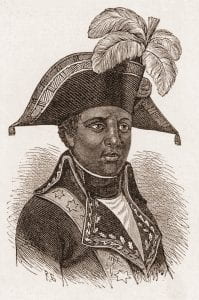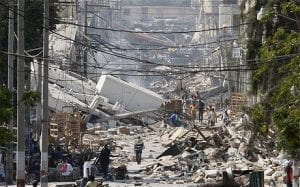| 5000 BCE — The island that now includes Haiti and the Dominican Republic is first inhabited (Girault). |
| 300 BCE —Farming villages made by the Arawak and other indigenous peoples, such as the Taino and the Ciboney, are formed, and they eventually become large communities (Girault). |
The 15th Century
| 1400s — By the 15th century, the large communities of Taino and Ciboney have grown to between 100,000 and several million people (Girault). |
| 1492 — Christopher Columbus arrives and dubs the island Hispaniola, or “Little Spain”, and within 50 years the indigenous people are nearly wiped out due to slavery and disease (“Haiti Profile – Timeline”; “History of Haiti”). |
The 17th Century
| 1697 — Spain cedes the western part of the island, named Saint Domingue, to France. The colony becomes one of the premier sugar producers for Britain and France and coffee producers for the world. This market, however, is fueled by a constant stream of African slaves brought to the colony by the French rulers after the indigenous people’s populations dwindled from earlier abuse (“Haiti Profile – Timeline”; “History of Haiti”). |
The 18th Century
| 1789 — African slaves outnumber the French colonizer population four-to-one. During this time, there are many attacks against colonizers’ settlements by runaway slaves, known as Maroons (“Haiti Profile – Timeline”; “History of Haiti”; “Haiti’s History”). |
| 1791 — Toussaint Louverture leads a group of former slaves in the first successful slave revolt in history, toppling the colony. Although the uprising is finally crushed, the events are a catalyst to what will become the Haitian Revolution. Over the next six years, Toussaint’s tactical skill and charismatic leadership will enable him to overtake the entire island (“Haiti Profile – Timeline”; “Haiti’s History”). |
The 19th Century
| 1801 — Toussaint Louverture conquers what is now called Haiti, abolishes slavery, and proclaims himself the governor-general of an autonomous government over all of Hispaniola through a constitution that is approved by the new Colonial Assembly (“Haiti Profile – Timeline”; “Haiti’s History”). |
| 1802 — However, Toussaint Louverture’s reign of the island is brief, as Napoleon Bonaparte dispatches troops to take control of the island. Louverture surrenders, with the condition that there will be no return to slavery. Louverture is captured, sent to the dungeon of Fort-de-Joux in France, and dies of pneumonia less than a year later (“Haiti Profile – Timeline”; “Haiti’s History”). |
| 1803 — War begins between France and Spain, and so Bonaparte is forced to draw his troops back from Haiti. Jean-Jacques Dessalines, one of Louverture’s generals, overruns the remaining French (“Haiti Profile – Timeline”; “Haiti’s History”). |
| 1804 — After 300 years of colonial rule, the new nation of Haiti, which means “mountainous,” is declared an independent republic. Jean-Jacques Dessalines declares himself emperor. This makes Haiti only the second nation in the Americas to gain its independence and the first modern state governed by people of African descent (“Haiti Profile – Timeline”; “Haiti’s History”). |
| 1806 — Despite its new independence, Haitian society remains hierarchical, with large disparities in wealth between mixed-race mulatto freedmen and newly freed blacks. The mulatto minority becomes the new elite in Haitian society, and they resist Dessalines, who is assassinated in 1806 (“Haiti Profile – Timeline”; “History of Haiti”). |
| 1818-1843 — General Jean-Pierre Boyer, a mulatto, reunites the country and is president for two decades, during which he negotiates a payment to France as a reparation for the loss of its colony. In exchange, France recognizes the Republic of Haiti and repairs trade relations, helping to secure Haiti’s political independence but imposing an enormous economic burden that will weigh heavily on future generations (“Haiti Profile – Timeline”; “History of Haiti”). |
The 20th Century
| 1915 — Economic stagnation plagues the country, in part due to the reparation paid to France and the deep-seated hostility that continues to exist between the blacks and mulattoes. Coups and assassinations as different presidents cycle through become commonplace. U.S. Marines are dispatched to Haiti to protect U.S. financial interests and citizens and seize control of the country, installing Phillippe Sudre Dartiguenave, a mulatto, as president from 1915 to 1922 (“Haiti Profile – Timeline”; “History of Haiti”). |
| 1934 — The U.S. withdraws troops from Haiti but maintains fiscal control until 1947 (“Haiti Profile – Timeline”). |
| 1956 — Francois “Papa Doc” Duvalier, known for his seemingly paternalistic treatment of poor and sick Haitians, seizes power in a military coup and is elected president a year later. However, his 14-year reign is characterized by harsh dictatorial methods (“Haiti Profile – Timeline”; “History of Haiti”). |
| 1971 — “Duvalier dies and is succeeded by his 19-year-old son, Jean-Claude, or ‘Baby Doc’, who also declares himself president-for-life” (“Haiti Profile – Timeline”). |
| 1986 — The Haitian people are discontent with Baby Doc’s presidency, as they yearn for improved access to food, water, education, and employment. Haitian citizens revolt against the administration, and Baby Doc gives up his presidency and goes into exile in France. Baby Doc is replaced by Lieutenant-General Henri Namphy as head of a governing council (“Haiti Profile – Timeline”; “History of Haiti”). |
| 1988 — Leslie Manigat becomes president, but is then ousted in a coup led by Brigadier-General Prosper Avril, who institutes a civilian government under military control (“Haiti Profile – Timeline”). |
| 1990-1999 — Power changes hands several times, with Rene Preval emerging as leader by decree in 1999 (“Haiti Profile – Timeline”). |
The 21st Century
| 2000 — Aristide is elected president again for his second non-consecutive term after a suspicious election (“Haiti Profile – Timeline”). |
| 2003 — Vodou is recognized as a religion (“Haiti Profile – Timeline”). |
| 2004 (January-February) — An uprising against President Aristide breaks out during the bicentennial celebrations of Haitian Independence. Aristide is forced into exile (“Haiti Profile – Timeline”). |
| 2004 (May-July) — Flooding in the south of Haiti and parts of the Dominican Republic leave more than 2,000 people dead or missing. Soon after, UN peacekeepers arrive to help flood survivors and international donors pledge over $1 billion in aid (“Haiti Profile – Timeline”). |
| 2004 (September) — “Nearly 3,000 are killed in flooding in the north in the wake of tropical storm Jeanne” (“Haiti Profile – Timeline”). |
| Late 2004 — Deadly political and gang violence breaks out in the capital from armed gangs loyal to former president Aristide (“Haiti Profile – Timeline”). |
| 2006 — General elections take place, and Rene Preval is declared the winner of the presidential vote. Jacques-Edouard Alexis is elected Prime Minister (“Haiti Profile – Timeline”). |
| 2008 (April) — Due to food riots, Prime Minister Alexis announces an emergency plan to cut the price of rice in an effort to calm the unrest. Parliament later dismisses him (“Haiti Profile – Timeline”). |
| 2008 (May) — The United States and the World Bank announce food aid totaling $30 million (“Haiti Profile – Timeline”). |
| 2008 (August – September) — Michele Pierre Louis becomes prime minister (“Haiti Profile – Timeline”). |
| 2009 (July) — The World Bank and the International Monetary Fund cancel 80% of Haiti’s debt ($1.2 billion) after judging that Haiti has fulfilled enough economic reform and poverty reduction initiatives (“Haiti Profile – Timeline”). |
| 2009 (October – November) — Jean-Max Bellerive becomes prime minister (“Haiti Profile – Timeline”). |
| 2010 (January) — A 7.0 magnitude earthquake – the worst in Haiti in two centuries – hits the capital of Port-au-Prince and its surrounding region, killing up to 300,000 people (“Haiti Profile – Timeline”). |
Works Cited
“Columbus landing on Hispaniola.” Wikimedia Commons, https://commons.wikimedia.org/wiki/File:Columbus_landing_on_Hispaniola.JPG.
“Francois Duvalier.” Encyclopedia of World Biography, https://www.notablebiographies.com/Du-Fi/Duvalier-Fran-ois.html.
Girault, Christian Antoine et al. (7 August 2019). Haiti. Encyclopedia Britannica. Retrieved from https://www.britannica.com/place/Haiti.
“Haiti’s History.” PBS, https://www.pbs.org/frontlineworld/rough/2007/12/haiti_belos_sonlinks.html. Accessed 7 November 2019.
“Haiti Profile – Timeline.” BBC News,11 February 2019, https://www.bbc.com/news/world-latin-america-19548814.
“History of Haiti.” Nations Online, https://www.nationsonline.org/oneworld/History/Haiti-history.htm. Accessed 7 November 2019.
“Jean-Jacques Dessalines.” Biography, https://www.biography.com/political-figure/jean-jacques-dessalines.
“Map of Haiti and the Dominican Republic.” The Afrikan Heritage Foundation, http://www.afrikanheritage.com/caricom-to-ask-u-n-for-monitoring-system-on-haiti-dominican-republic/.
“People walk on a debris-covered street in Port-au-Prince in the aftermath of the earthquake that measured 7.0-magnitude in Haiti, 2010.” The Telegraph, https://www.telegraph.co.uk/news/worldnews/centralamericaandthecaribbean/haiti/8549193/Haiti-earthquake-death-toll-exaggerated-US-report-finds.html.
“Toussaint L’Ouverture.” The New York Times, https://www.nytimes.com/2016/12/09/books/review/a-biography-reveals-surprising-sides-to-haitis-slave-liberator.html.
Simon Glover, Jenna Whiting, Samantha Diaz, Shane McGarry, 2019








